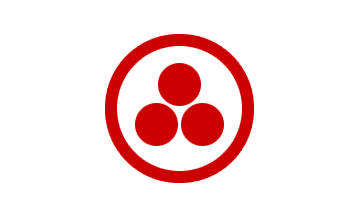
Last modified: 2008-02-28 by antónio martins
Keywords: pacifism | international banner of peace | roerich movement | reriq (nikolai~) | disc (red) | discs: 1+2 | madonna oriflamma | painting | saint mary | historical ruins symbol | monument | protection |
Links: FOTW homepage |
search |
disclaimer and copyright |
write us |
mirrors

The world peace flag is based on a design by
the Russian artist and mystic Nichola Roerich, who
proposed the red circle with three dots inside as an
international symbol to mark
museums, schools, and similar cultural landmarks to
prevent destruction by aerial bombs … this about
the time of World War I. The idea was similar to the
large red cross that
marks hospitals and hospital tents in war zones
… similarly to “prevent” bombing and
strafing of helpless patients and medical personnel.
The concept has been lost in today’s world.
William Dunning, 17 Mar 1998
The International Banner of Peace has three dots
representing the past, present and future enclosed
in a red circle representing infinity. It was
devised after World War I by Nicholas Roerich,
a Russian artist of German descent who spent most
of his life in India painting and developing mystic
philosophies.
(Source: The Moscow Times, March 25, 1998)
Alexei Arkhipov, 25 Mar 1998
Nikolaĭ Reriq | Николай Рерих was a german descent russian mysticist, painter and philosopher (approx. 1870-1946; original german spelling "Roerich"). He is very popular in nowadays Russia, where his followers are organized in a cultural movement more or less related with “New Age” tendencies. They use as their symbol the device shown above — which was orginally designed by Roerich himself and it is charged with some more or less deep symbolism: from memory, the three dots stand for art, science and philosophy (including religion), encircled and bounded toghether to form culture: "∴⃝". This symbol appears on one of Roerich’s paintings, Madonna Oriflamma, from 1932, which depicts Saint Mary holding and showing a white cloth with it.
I know nothing of the current usage of this flag, promoted originally by Roerich as the “International Banner of Peace”, in the lines of what is reported bellow, but two things:
Note that the shade of red used in this flag is slightly
darker than usual. This is not a mistake. Every instance I
found of the symbol was shown in darker shades of red.
A.H., 29 Nov 1999
The Roerich Peace Pact was signed in Washington in
1935 by the US and 20 Latin American countries. Other
countries, including Soviet Union, added their
signatures in 1959.The flag became a symbol of
commitment to the protection of historical, cultural
or scientifically significant monuments.
(Source: The Moscow Times, March 25, 1998)
Alexei Arkhipov, 25 Mar 1998
I don’t know how extensively has the pact flag been used.Protection of Artistic and Scientific Institutions and Historic Monuments
The High Contracting Parties, animated by the purpose of giving conventional form to the postulates of the Resolution approved on December 16, 1933, by all the States represented at the Seventh International Conference of American States, held at Montevideo, which recommended to «the Governments of America which have not yet done so that they sign the ’Roerich Pact’, initiated by the Roerich Museum in the United States, and which has as its object, the universal adoption of a flag, already designed and generally known, in order thereby to preserve in any time of danger all nationally and privately owned immovable monuments which form the cultural treasure of peoples», have resolved to conclude a treaty with that end in view, and to the effect that the treasures of culture be respected and protected in time of war and in peace, have agreed upon the following articles: (…)ARTICLE III
In order to identify the monuments and institutions mentioned in article I, use may be made of a distinctive flag (red circle with a triple red sphere in the circle on a white background) in accordance with the model attached to this treaty.
signed by the US and other Pan-American Union states, 15 April 1935
Anything below this line was not added by the editor of this page.